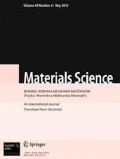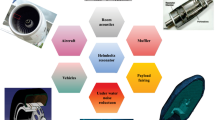We study the possibility of application the eddy-current method with impulsive excitation for the monitoring of the diameter and electric conductivity of cylindrical objects. For the processing of informative signals of a transducer, it is proposed to use the Hilbert transformation and a condition for the narrow- and wide-band “eddy-current transducer–tested object” systems, which would enable us to specify the spectral composition of the signals in the stage of design of the eddy-current devices.


Similar content being viewed by others
References
A. Ya. Teterko and Z. T. Nazarchuk, Selective Eddy-Current Nondestructive Testing [in Ukrainian], Karpenko Physicomechanical Institute, Ukrainian National Academy of Sciences, Lviv (2004).
V. M. Uchanin, Surface Double Differential Eddy-Current Transducers [in Ukrainian], SPOLOM, Lviv (2013).
B. Raj, T. Jayakumar, and M. Thavasimuthu, Practical Non-Destructive Testing, Publishing, Cambridge (2002).
M. J. Johnson, Pulsed Eddy-Current Measurements for Materials Characterization and Flaw Detection, Doctoral Thesis, University of Surrey (1997)
K. P. Dharmasena and N. H. G. Wadley, “Modeling multifrequency eddy current transducer interactions during vertical Bridgman growth of semiconductors,” Rev. Sci. Instrum., 70, No. 7, 3125–3142 (1999).
J. Bowler and M. Johnson, Pulsed eddy-current response to a conducting half-space,” IEEE Trans. Magn., 33, No. 3, 2258–2264 (1997).
J. Pavo, “Numerical calculation method for pulsed eddy-current testing,” IEEE Trans. Magn., 38, No. 2, 1169–1172 (2002).
Yu. Yu. Lysenko and Yu. V. Kuts, “Investigation of the impulsive excitation mode of eddy-current transducers,” in: Abstr. of the 7th National Scientific-Technical Conf. (Kyiv, November 20–23, 2012) [in Ukrainian], Kyiv (2012), p. 439.
Yu. V. Kuts and Yu. Yu. Lysenko, “Impulsive eddy-current testing of cylindrical objects,” Vestn. NTUU “KPI.” Ser. Priborostroen., No. 45, 69–75 (2013).
B. M. Gorkunov, I. P. Tyupa, and A. A. Tishchenko, “Model of a through-type eddy-current transducer with conducting cylindrical specimen,” Tekh. Elektrodynam., Topic Issue “Force Electronics and Power Efficiency,” Part 5, 45–48 (2007).
O. F. Zakrevskyi and A. V. Movchanuk, “The model of eddy-current probe,” Sci. Proc. “NDT Days 2012,” No. 1 (133), 252–254 (2012).
Author information
Authors and Affiliations
Corresponding author
Additional information
Translated from Fizyko-Khimichna Mekhanika Materialiv, Vol. 52, No. 3, pp. 120–125, May–June, 2016.
Rights and permissions
About this article
Cite this article
Kuts, Y.V., Lysenko, Y.Y., Dugin, A.L. et al. Analysis of an Eddy-Current Transducer with Impulsive Excitation in the Nondestructive Testing of Cylindrical Objects. Mater Sci 52, 431–437 (2016). https://doi.org/10.1007/s11003-016-9975-4
Received:
Published:
Issue Date:
DOI: https://doi.org/10.1007/s11003-016-9975-4




